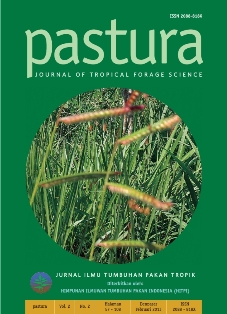PRODUKSI BIOMASSA DAN NILAI NUTRISI RUMPUT PAKAN PADA TANAH DENGAN TINGKAT SALINITAS BERBEDA
Abstract
Salt from sea water can ingress through groundwater, rivers and estuaries that cause large areas of salt-affected soils. The presence of excess salts on the soil surface and in the root zone inhibits crop growth and production. An electrical conductivity of the saturation soil extract at saline soil is more than 4 dS/m. A experiment was conducted to identify potentially suitable forage grasses for growing at saline soil Five forage grasses were tested in greenhouse. They were Panicum maximum, Setaria sphacelata, Euchlaena mexicana, Brachiaria brizantha, and Cynodon plectostachyus. Grasses were planted at non-saline soil (EC = 0.5 dS/m) and saline soil (EC = 11 dS/m). Biomass yield and nutritional value of grasses were evaluated. Biomass yield (fresh and dry matter of shoot and root) was significantly reduced at saline soil compared with non-saline soil. Ranking of forages according to the percent reduction in biomass yield due to the higher level of salinity was Brachiaria brizantha > Euchlaena mexicana > Panicum maximum > Cynodon plectostachyus > Setaria sphacelata. Crude protein percentage of Brachiaria brizantha was significantly lower at saline soil compared with non saline soil. While there were no significantly different of crude protein between non-saline soil and saline soil of Panicum maximum, Setaria sphacelata, Euchlaena mexicana and Cynodon plectostachyus. Acid detergent fiber and neutral detergent fiber of Brachiaria brizantha were significantly higher at saline soil. So, Brachiaria brizantha was judged as the worst species in terms of biomass yield and nutritional value. Although, the percentage reduction biomass yield of Cynodon plectostachyus at saline soil was low, Cynodon plectostachyus was judged to be unacceptable because of its poor nutritional value and low production. Euchlaena mexicana had lower biomass at saline soil, also it had lower nutritional value compared with Panicum maximum. In conclusion, based on biomass yield and nutritional value, Panicum maximum and Setaria sphacelata were judged to be the best species at saline soil.Downloads
Download data is not yet available.
How to Cite
F, Kusmiyati; KARNO, Sumarsono; PANGESTU, E..
PRODUKSI BIOMASSA DAN NILAI NUTRISI RUMPUT PAKAN PADA TANAH DENGAN TINGKAT SALINITAS BERBEDA.
Pastura, [S.l.], v. 2, n. 2, june 2014.
ISSN 2549-8444.
Available at: <https://ojs.unud.ac.id/index.php/pastura/article/view/9027>. Date accessed: 03 jan. 2026.
doi: https://doi.org/10.24843/Pastura.2013.v02.i02.p07.
Issue
Section
Articles
Keywords
biomass, nutritional value, grasses, saline, nonsaline





